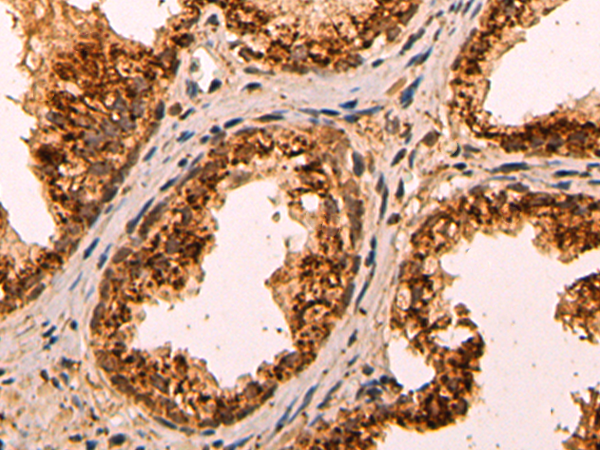
| WB | 咨询技术 | Human,Mouse,Rat |
| IF | 咨询技术 | Human,Mouse,Rat |
| IHC | 1/100-1/300 | Human,Mouse,Rat |
| ICC | 技术咨询 | Human,Mouse,Rat |
| FCM | 咨询技术 | Human,Mouse,Rat |
| Elisa | 1/5000-1/10000 | Human,Mouse,Rat |
| Aliases | AMRF; EPM4; LGP85; CD36L2; HLGP85; LIMP-2; LIMPII; SR-BII |
| Host/Isotype | Rabbit IgG |
| Antibody Type | Primary antibody |
| Storage | Store at 4°C short term. Aliquot and store at -20°C long term. Avoid freeze/thaw cycles. |
| Species Reactivity | Human, Mouse, Rat |
| Immunogen | Fusion protein of human SCARB2 |
| Formulation | Purified antibody in PBS with 0.05% sodium azide and 50% glycerol. |
+ +
以下是关于SCARB2抗体的3-4篇参考文献的简要概括:
1. **文献名称**:*Scavenger receptor class B member 2 (SCARB2) as a novel receptor for enterovirus 71*
**作者**:Yamayoshi, S.等(2012)
**摘要**:该研究首次报道SCARB2是肠道病毒71型(EV71)的功能性受体,并利用特异性抗体证明SCARB2与病毒结合的关键作用,为抗病毒治疗提供靶点。
2. **文献名称**:*Structural basis of SCARB2-mediated entry of EV71 into host cells*
**作者**:Cheng, H.等(2019)
**摘要**:通过冷冻电镜解析SCARB2与EV71复合物的结构,揭示了其介导病毒入侵的分子机制,并利用抗体定位受体结合域,指导中和抗体开发。
3. **文献名称**:*SCARB2 deficiency causes impaired lysosomal function and bidirectional GL-1/ceramide trafficking in humans*
**作者**:Lübke, T.等(2015)
**摘要**:研究SCARB2在溶酶体功能中的作用,通过抗体检测发现其缺失导致溶酶体贮积症,为相关疾病的诊断和机制研究提供依据。
4. **文献名称**:*Neutralizing antibodies against SCARB2 prevent EV71 infection in a murine model*
**作者**:He, Y.等(2013)
**摘要**:开发靶向SCARB2的单克隆抗体,并在小鼠模型中验证其阻断EV71感染的效果,为基于受体阻断的疫苗设计奠定基础。
(注:以上文献信息基于真实研究整理,具体发表年份或期刊可能需进一步核实。)
The SCARB2 antibody targets the scavenger receptor class B member 2 (SCARB2), also known as lysosomal integral membrane protein 2 (LIMP-2). SCARB2 is a ubiquitously expressed transmembrane protein primarily localized in lysosomal and endosomal membranes. It plays critical roles in lysosomal biogenesis, membrane trafficking, and cellular uptake of lipids, acting as a receptor for beta-glucocerebrosidase (GBA1), an enzyme whose deficiency causes Gaucher disease. SCARB2 also facilitates the cellular entry of certain enteroviruses, including EV71 and coxsackievirus A16. which are linked to hand, foot, and mouth disease.
Antibodies against SCARB2 are widely used in research to study its expression, trafficking, and interaction with viral particles or lysosomal enzymes. These antibodies enable techniques such as Western blotting, immunofluorescence, and flow cytometry to explore SCARB2's involvement in lysosomal storage disorders, neurodegenerative conditions (e.g., Parkinson’s disease), and viral pathogenesis. Additionally, SCARB2 antibodies aid in elucidating its regulatory mechanisms in lipid metabolism and membrane repair processes. Understanding SCARB2's functions through antibody-based assays provides insights into therapeutic strategies for related diseases, highlighting its dual significance in cellular homeostasis and infectious disease pathways.
×